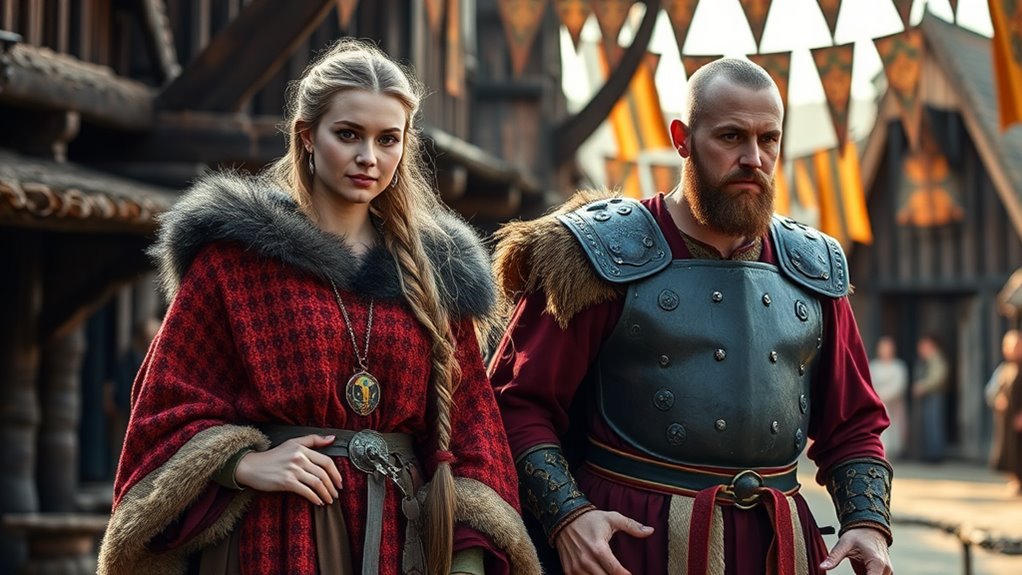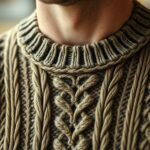So, you’re gearing up for that Viking festival, huh? Forget the flimsy costumes most people stick to. You want to stand out and look authentic. Real Viking attire is all about wool, linen, and leather. It’s rugged but comfy. Want to know how to mix style with practicality? Curious about what makes that perfect warrior vibe? Let’s investigate the critical components and uncover some unique twists that’ll set your look apart!
Understanding Viking Fashion: A Historical Overview
When you think about Viking fashion, you might picture horned helmets and fancy capes, right? But there’s so much more.
The Norse were incredibly skilled in textile production. Their clothing was both practical and stylish. They used materials like wool and linen, crafted meticulously to endure harsh climates.
Viking textile craftsmanship was a blend of artistry and utility. Each piece carried a story, often showcasing intricate patterns unique to families or regions. Additionally, the Vikings embraced layering for versatility in their clothing, allowing them to adapt to varying weather conditions while maintaining a fashionable appearance.
Key Elements of Authentic Viking Attire
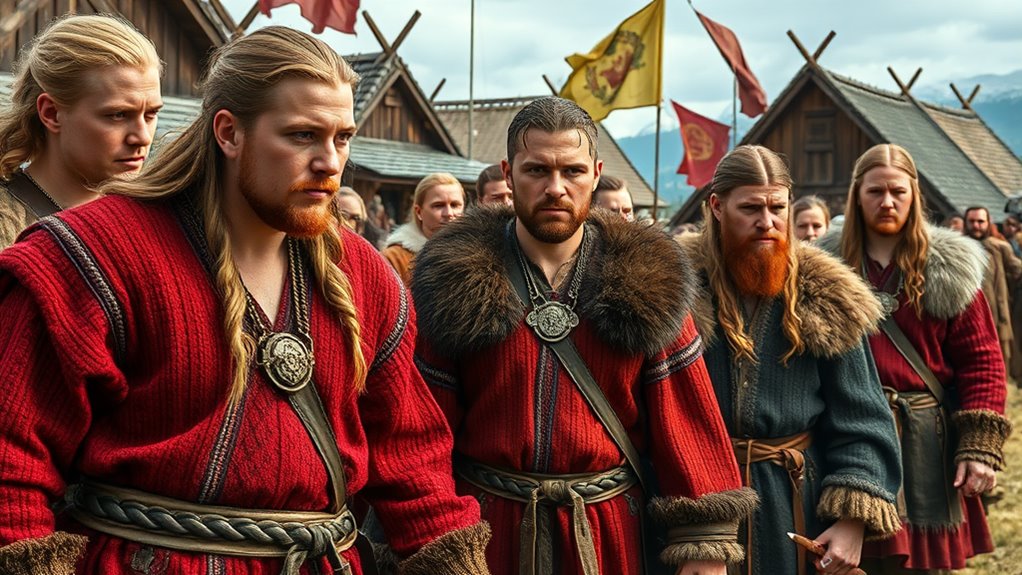
To really nail that authentic Viking look at a festival, you’ll want to focus on a few key elements that make up their attire. Initially, think about the use of textile materials. Vikings preferred wool, linen, and leather—because who doesn’t love something comfy yet rugged?
To achieve an authentic Viking festival look, prioritize wool, linen, and leather for a rugged yet comfortable style.
Next, let’s talk hair. Braiding techniques weren’t just stylish; they served practical purposes too. You could experiment with your hair—braids can add flair to your outfit.
Accessories matter! Consider adding a simple brooch or some beads. Don’t overdo it, though—less is more! Incorporating your look with a cloak or hood can really accentuate your wardrobe. Additionally, understanding the importance of authentic textile materials can enhance the overall historical accuracy of your outfit.
Embrace the spirit of the Vikings, and you’ll stand out while staying true to history!
Choosing the Right Tunic: Styles and Fabrics
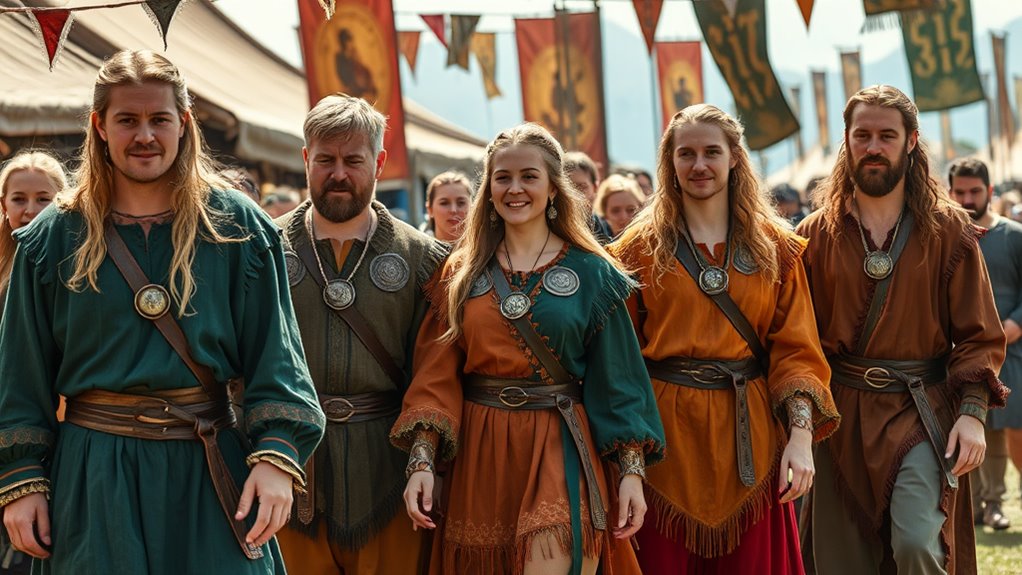
You know that feeling when you put on something that just clicks? Choosing the right tunic can do just that. But you don’t want to look like an extra from a low-budget Viking movie.
Here are some tips to help you out:
- Fabrics with Patterns: Think unique designs! They add character and a nod to historical authenticity.
- Tunic Length Variations: Shorter tunics can keep you cool, while longer ones are great for a more traditional look.
- Layering Options: Consider wearing a shirt underneath for added depth and style.
- Color Choices: Earthy colors or bold hues? It’s your choice—just make sure it speaks to you! Additionally, choosing sustainable materials can enhance your outfit while supporting the movement towards sustainable fashion.
Armor and Accessories: Completing Your Look
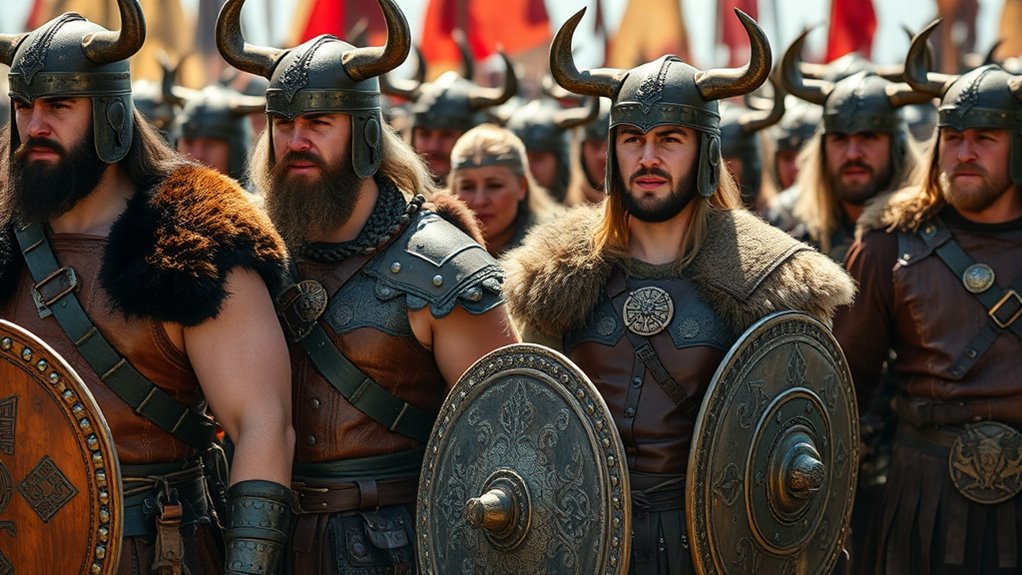
Choosing the right tunic sets the stage for your Viking look, but what you add next really brings it to life.
Think about armor—real, functional armor materials that not only look cool but also offer some protection. Leather or chainmail can add authenticity, so don’t skimp here!
Next, grab a ceremonial shield. Choose one with bold designs that capture the spirit of the Viking age. It’s not just a prop; it’s a statement piece! You’ll stand out and feel like a true warrior.
Don’t forget accessories like a sturdy belt and a good pair of boots. They tie everything together, making you look ready to raid a festival—or at least enjoy the festivities in style! Additionally, consider incorporating traditional attire elements that reflect the historical roots of your character.
Shieldmaidens’ Styles: Feminine Touches of the Era
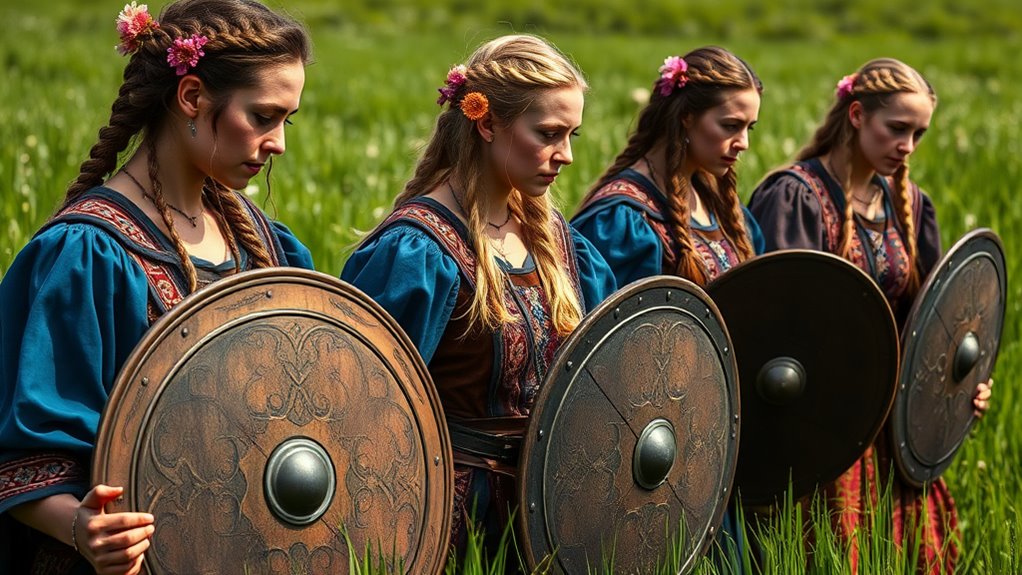
Viking style isn’t just about armor and brute strength; it’s also an expression of identity, especially for shieldmaidens. They combined toughness with elegance in ways that made them truly unique.
Viking style embodies a blend of strength and elegance, capturing the unique identity of shieldmaidens.
To reflect this fierce femininity at the festival, consider these elements:
- Delicate Embroidery: Incorporating intricate stitching on your garments adds a personal touch and showcases craftsmanship.
- Floral Accents: These patterns, whether on skirts or cloaks, bring a refreshing touch to traditionally heavy outfits.
- Layered Textiles: Play with diverse fabrics, creating dimension and movement in your look.
- Accessorized Hairstyles: Adorn your hair with braids and flowers to complete the warrior-woman vibe. Additionally, incorporating cozy sweaters into your ensemble can provide both warmth and style as you embrace the festival atmosphere.
Embrace your inner shieldmaiden and stand out in style!
Footwear Fit for a Warrior: Viking Boots and Shoes
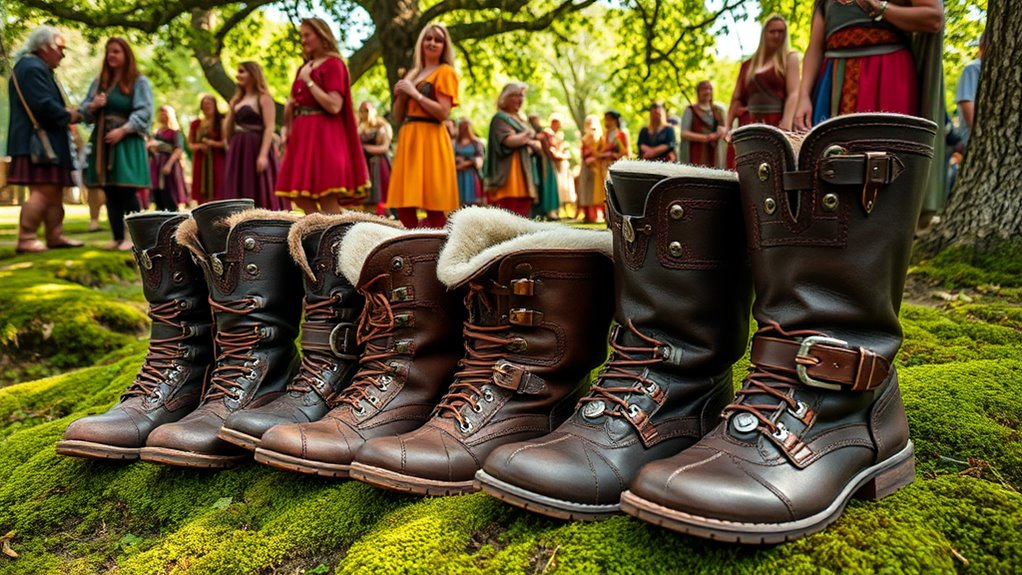
As regards embodying the warrior spirit at a Viking festival, footwear frequently gets overtaken by shiny armor or elaborate costumes. Don’t make that mistake! Viking inspired footwear is where you can really show off your connection to the past. Think rugged and practical—your feet will thank you. Consider incorporating classic sneakers for a comfortable yet stylish option as you navigate the festivities.
Here’s some options to ponder:
| Style | Description | Material |
|---|---|---|
| Tall Boots | Lace-up and knee-high, perfect for combat | Sturdy leather soles |
| Low Shoes | Flat, easy to wear for casual looks | Soft leather |
| Sandals | Open design, great for warmer days | Durable leather |
| Nordic Slippers | Cozy for nighttime gatherings | Thick wool lining |
Choose wisely, and your feet will feel as fierce as a true warrior’s!
The Importance of Color and Patterns in Viking Wear
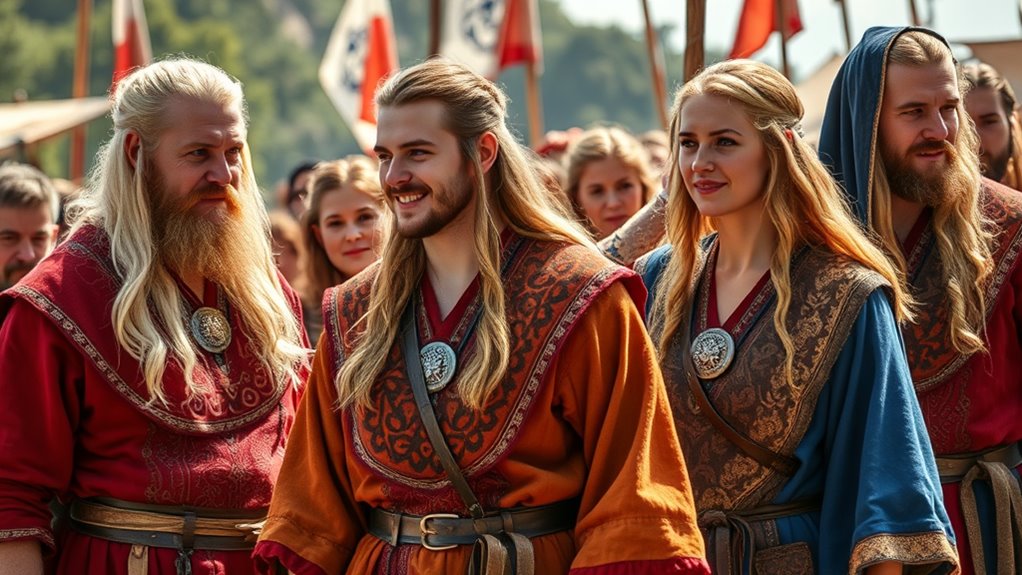
Colors and patterns aren’t just for show; they tell stories about who you’re and where you come from. When choosing your Viking attire, remember these vital elements:
Colors and patterns convey stories of identity and heritage, playing a crucial role in Viking attire selection.
- Symbolic Meanings: Each color carries significance. For example, blue often represented loyalty, while red could signify bravery.
- Cultural Significance: Patterns like the intricate knotwork weren’t just decorative; they connected you to your ancestors.
- Status Indicators: Richer colors and elaborate patterns often indicated higher social rank. Go bold if you want to stand out!
- Regional Variations: Colors and patterns changed based on your location, giving clues about your heritage and community. Additionally, embracing earthy tones in your color palette can enhance your Viking-inspired look while connecting to nature.
Hair and Beard Trends From the Viking Age
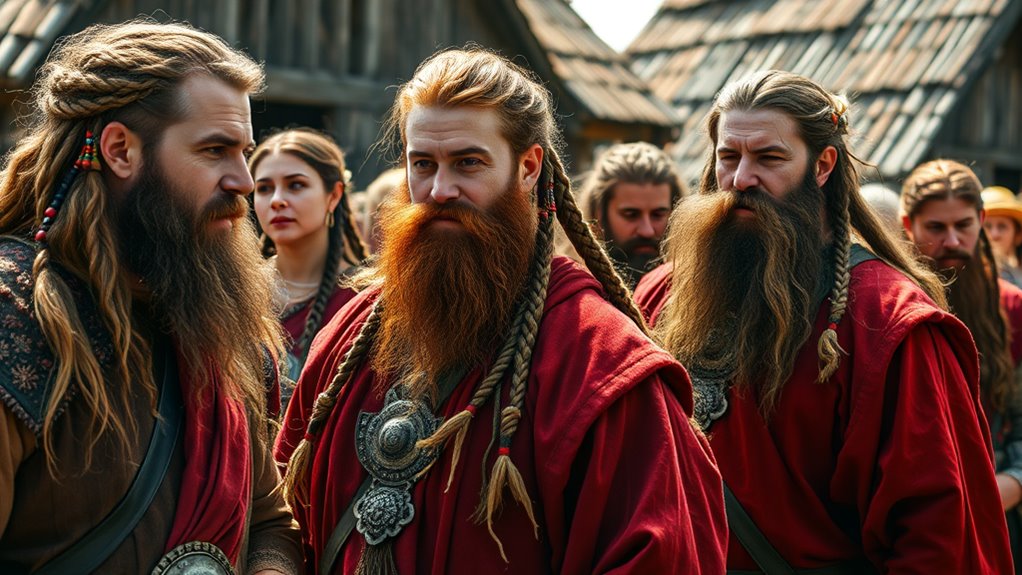
When you’re diving into the world of Viking attire, don’t overlook hair and beard trends—they’re as integral as the clothing itself. Vikings had unique grooming habits that set them apart. Long hair was often plaited, showcasing intricate plaiting techniques. Beards? They weren’t just for show.
| Trend | Description |
|---|---|
| Plaiting | Complex styles to flaunt your skill |
| Groomed Beards | Neatly trimmed for a fierce look |
| Natural Textures | Embracing wild, untamed styles |
Maintaining courtroom decorum was also important, as it reflected the respect and dignity of the Viking culture.
DIY Viking Costume Ideas for Creative Souls
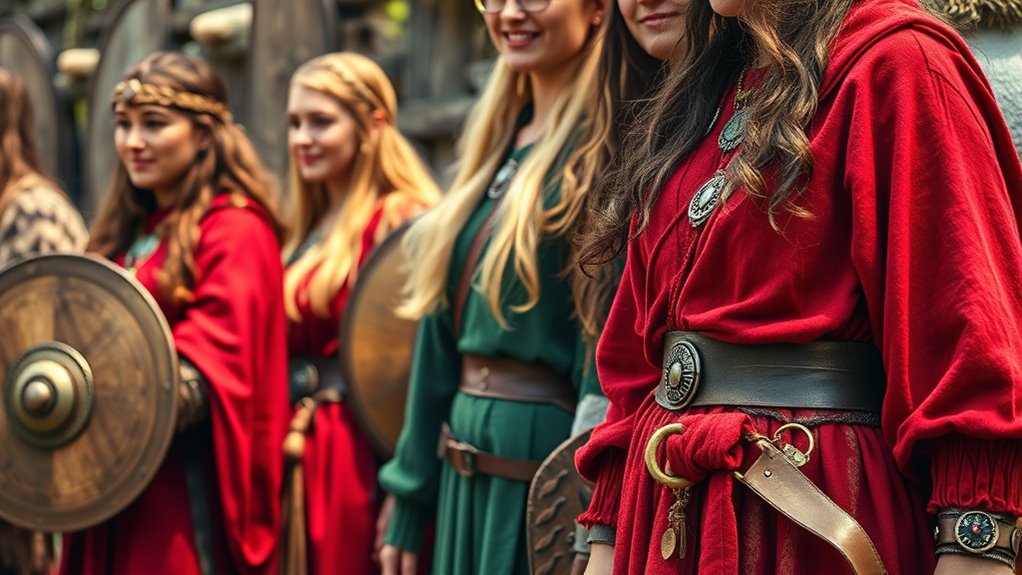
Ready to plunge into the world of Viking creativity? You’ve got the chance to make a killer DIY Viking costume that screams your creative personal style. Forget the cookie-cutter looks and try these unique historical touches:
Dive into Viking creativity with a DIY costume that showcases your unique style and historical flair!
- Layered Tunics: Grab some fabric and mix textures for a layered look.
- Customized Shields: Use cardboard and paint to design a personal shield that stands out.
- Fierce Accessories: Craft a belt from leather scraps or faux fur.
- Intrepid Footwear: Transform old boots with fabric and faux fur for that rugged Viking vibe. Consider pairing them with classic ankle boots for a modern twist on traditional Viking footwear.
Tips for Maintaining Comfort During the Festival
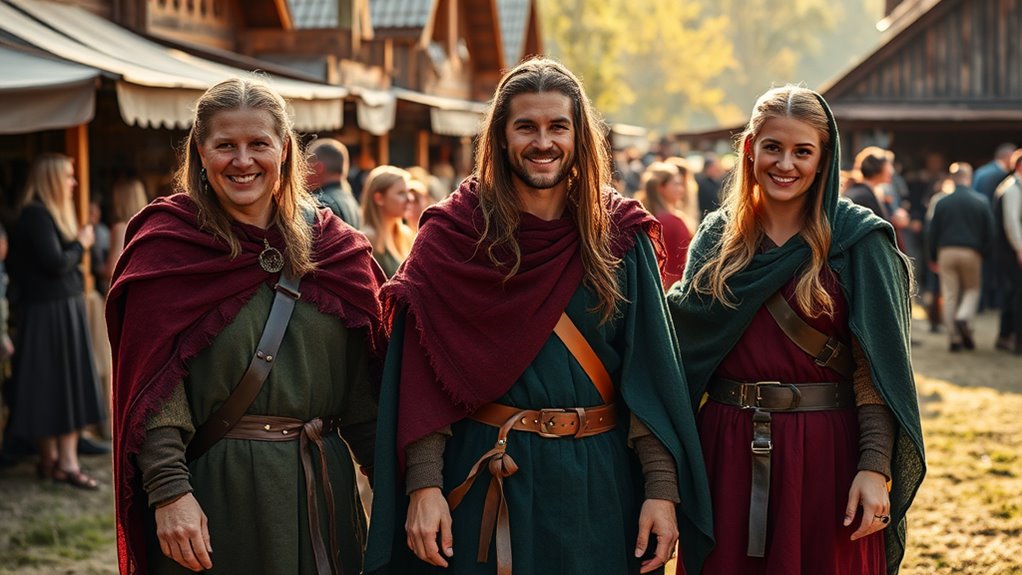
You’ve got your awesome DIY Viking costume ready, but let’s talk about keeping comfy while you’re rocking it at the festival! Initially, think layering techniques. You don’t want to sweat through your shirt or freeze because you’re sporting too much faux fur. Start with a breathable base layer to wick away moisture.
Next, add a cozy middle layer to keep you warm, but don’t overdo it; nobody wants to be the sweaty Viking. Temperature regulation is key here. Festivals can swing from sunny to chilly, so keep an eye on the forecast. Bring along a cape or shawl you can easily toss on or off. Trust me, comfort will make your Viking experience way more epic! Consider incorporating smart layering techniques to ensure you stay comfortable throughout the day. Ready to slay the day?
